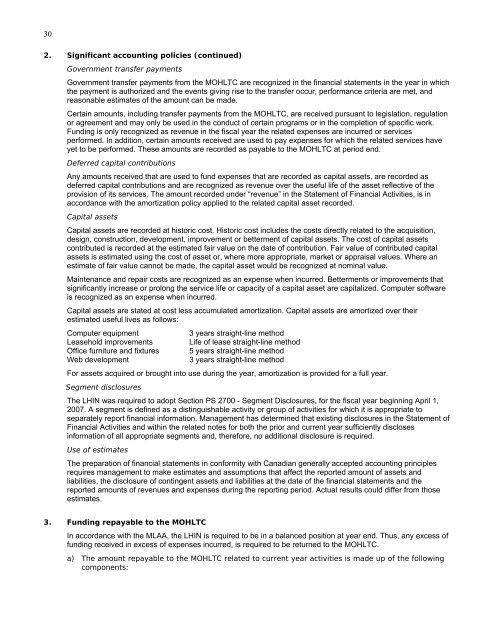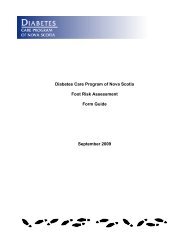2009-10 Annual Report - Central East Local Health Integration ...
2009-10 Annual Report - Central East Local Health Integration ...
2009-10 Annual Report - Central East Local Health Integration ...
You also want an ePaper? Increase the reach of your titles
YUMPU automatically turns print PDFs into web optimized ePapers that Google loves.
30<br />
2. Significant accounting policies (continued)<br />
Government transfer payments<br />
Government transfer payments from the MOHLTC are recognized in the financial statements in the year in which<br />
the payment is authorized and the events giving rise to the transfer occur, performance criteria are met, and<br />
reasonable estimates of the amount can be made.<br />
Certain amounts, including transfer payments from the MOHLTC, are received pursuant to legislation, regulation<br />
or agreement and may only be used in the conduct of certain programs or in the completion of specific work.<br />
Funding is only recognized as revenue in the fiscal year the related expenses are incurred or services<br />
performed. In addition, certain amounts received are used to pay expenses for which the related services have<br />
yet to be performed. These amounts are recorded as payable to the MOHLTC at period end.<br />
Deferred capital contributions<br />
Any amounts received that are used to fund expenses that are recorded as capital assets, are recorded as<br />
deferred capital contributions and are recognized as revenue over the useful life of the asset reflective of the<br />
provision of its services. The amount recorded under “revenue” in the Statement of Financial Activities, is in<br />
accordance with the amortization policy applied to the related capital asset recorded.<br />
Capital assets<br />
Capital assets are recorded at historic cost. Historic cost includes the costs directly related to the acquisition,<br />
design, construction, development, improvement or betterment of capital assets. The cost of capital assets<br />
contributed is recorded at the estimated fair value on the date of contribution. Fair value of contributed capital<br />
assets is estimated using the cost of asset or, where more appropriate, market or appraisal values. Where an<br />
estimate of fair value cannot be made, the capital asset would be recognized at nominal value.<br />
Maintenance and repair costs are recognized as an expense when incurred. Betterments or improvements that<br />
significantly increase or prolong the service life or capacity of a capital asset are capitalized. Computer software<br />
is recognized as an expense when incurred.<br />
Capital assets are stated at cost less accumulated amortization. Capital assets are amortized over their<br />
estimated useful lives as follows:<br />
Computer equipment<br />
3 years straight-line method<br />
Leasehold improvements Life of lease straight-line method<br />
Office furniture and fixtures 5 years straight-line method<br />
Web development<br />
3 years straight-line method<br />
For assets acquired or brought into use during the year, amortization is provided for a full year.<br />
Segment disclosures<br />
The LHIN was required to adopt Section PS 2700 - Segment Disclosures, for the fiscal year beginning April 1,<br />
2007. A segment is defined as a distinguishable activity or group of activities for which it is appropriate to<br />
separately report financial information. Management has determined that existing disclosures in the Statement of<br />
Financial Activities and within the related notes for both the prior and current year sufficiently discloses<br />
information of all appropriate segments and, therefore, no additional disclosure is required.<br />
Use of estimates<br />
The preparation of financial statements in conformity with Canadian generally accepted accounting principles<br />
requires management to make estimates and assumptions that affect the reported amount of assets and<br />
liabilities, the disclosure of contingent assets and liabilities at the date of the financial statements and the<br />
reported amounts of revenues and expenses during the reporting period. Actual results could differ from those<br />
estimates.<br />
3. Funding repayable to the MOHLTC<br />
In accordance with the MLAA, the LHIN is required to be in a balanced position at year end. Thus, any excess of<br />
funding received in excess of expenses incurred, is required to be returned to the MOHLTC.<br />
a) The amount repayable to the MOHLTC related to current year activities is made up of the following<br />
components:

















